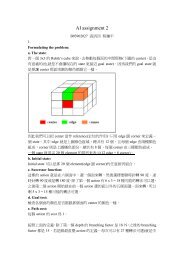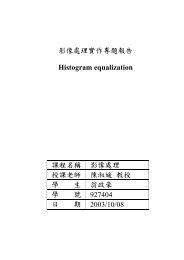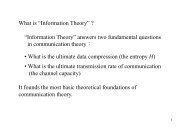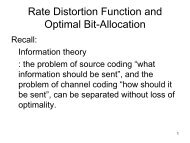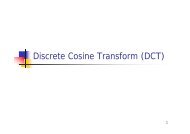Exaggeration of Facial Features in Caricaturing
Exaggeration of Facial Features in Caricaturing
Exaggeration of Facial Features in Caricaturing
Create successful ePaper yourself
Turn your PDF publications into a flip-book with our unique Google optimized e-Paper software.
difficult. Therefore, our system has to f<strong>in</strong>d out the features’<br />
<strong>in</strong>formation by manually mark<strong>in</strong>g the feature po<strong>in</strong>ts.<br />
Mark<strong>in</strong>g those po<strong>in</strong>ts is very easy because users only need to<br />
<strong>in</strong>dicate a few key po<strong>in</strong>ts <strong>in</strong> the <strong>in</strong>put picture. From those<br />
key po<strong>in</strong>ts, our system can simulate the outl<strong>in</strong>es <strong>of</strong> features<br />
by connect<strong>in</strong>g the key po<strong>in</strong>ts <strong>in</strong> the form <strong>of</strong> a Bezier curve.<br />
Then, our system generates the output by apply<strong>in</strong>g our<br />
exaggeration rules and color<strong>in</strong>g <strong>in</strong> tone-shad<strong>in</strong>g. It deserves<br />
to be mentioned that users can <strong>in</strong>teract with our system to<br />
adjust the degree <strong>of</strong> exaggeration.<br />
A common usage <strong>of</strong> various styles <strong>of</strong> caricatur<strong>in</strong>g is seen<br />
<strong>in</strong> political comics. Draw<strong>in</strong>g those politicians or movie stars<br />
with deliberate exaggeration together with funny<br />
conversation always makes people laugh. Our system has<br />
advantages <strong>in</strong> help<strong>in</strong>g people who are not good at draw<strong>in</strong>g to<br />
generate funny caricatures <strong>in</strong> a short time, or help<strong>in</strong>g artists<br />
to quickly generate basic caricatures, which can be ref<strong>in</strong>ed<br />
afterward.<br />
In the rema<strong>in</strong>der <strong>of</strong> this paper, we describe our method <strong>of</strong><br />
exaggeration <strong>in</strong> Section 2 and the details <strong>of</strong> our system<br />
implementation <strong>in</strong> Section 3.<br />
2 <strong>Facial</strong> <strong>Exaggeration</strong>s<br />
In order to be able to identify who is <strong>in</strong> the pictorial <strong>in</strong><br />
which the face’s dist<strong>in</strong>ctive features are deliberately<br />
exaggerated, the whole ratio <strong>of</strong> the objective face cannot be<br />
changed. For example, a round face cannot be exaggerated<br />
to a th<strong>in</strong> face, and the ratio <strong>of</strong> the center <strong>of</strong> the eye to the rest<br />
<strong>of</strong> the face cannot be changed.<br />
So, we can only exaggerate features without destroy<strong>in</strong>g<br />
the whole ratio <strong>of</strong> the face. If we feel that the eyes are big,<br />
we can exaggerate them by us<strong>in</strong>g the <strong>in</strong>ner corner <strong>of</strong> the eye<br />
as the central po<strong>in</strong>t and <strong>in</strong>creas<strong>in</strong>g the size proportionally. If<br />
we feel that the nose is big, we can exaggerate it by us<strong>in</strong>g<br />
the bottom <strong>of</strong> the nose as the central po<strong>in</strong>t and <strong>in</strong>creas<strong>in</strong>g the<br />
size proportionally. In an extreme case, the adjusted nose<br />
becomes so big that it covers part <strong>of</strong> the mouth.<br />
2.1 Rules for the Face<br />
There are some features <strong>of</strong> our face, such as the forehead,<br />
cheekbone, jaw, and whole shape… etc. There are three rules<br />
for the face:<br />
Rule 1: If someone’s forehead is taller / shorter, we<br />
<strong>in</strong>crease / decrease the distance between the hairl<strong>in</strong>e and the<br />
brow.<br />
Rule 2: If someone’s cheekbone is bigger / smaller, we<br />
move the control po<strong>in</strong>ts <strong>of</strong> the cheekbone to change the<br />
curvature <strong>of</strong> the cheekbone and emphasize the characteristic.<br />
Rule 3: If someone has long jaw, we lengthen the jaw.<br />
2.2 Rules for the Eyes<br />
There are two characteristics <strong>of</strong> our eyes, the size and the<br />
shape. These two characteristics are <strong>in</strong>dependent from each<br />
other. There are two rules for the eyes:<br />
Rule 1: If the eyes are bigger or smaller, we change the<br />
size <strong>of</strong> them by keep<strong>in</strong>g the distance between the <strong>in</strong>ner<br />
corners <strong>of</strong> the two eyes the same.<br />
Rule 2: If the eyes are like some k<strong>in</strong>d <strong>of</strong> shape, we<br />
enlarge the angle between the eye and the horizontal l<strong>in</strong>e by<br />
keep<strong>in</strong>g the positions <strong>of</strong> the eyes’ <strong>in</strong>ner corners the same<br />
2.3 Rules for the Nose<br />
There are several characteristics <strong>of</strong> our nose, such as size<br />
and shape, etc. There are three rules for the nose:<br />
Rule 1: If the nose is big, we enlarge the size <strong>of</strong> the nose<br />
by us<strong>in</strong>g the bottom <strong>of</strong> the nose as the central po<strong>in</strong>t.<br />
Enlarg<strong>in</strong>g the size may cause the nose to cover part <strong>of</strong> the<br />
mouth.<br />
Rule 2: If the nose is hook-nosed, we make the nose tip<br />
lower and keep the other parts <strong>of</strong> nose the same. On the<br />
contrary, if the nose is snub-nosed, we make the nose tip<br />
higher.<br />
Rule 3: If the nose is high-bridged, we can bend the<br />
bridge <strong>of</strong> the nose to emphasize this characteristic.<br />
2.4 Rules for the Mouth<br />
Our mouth consists <strong>of</strong> two lips, the upper lip and the<br />
lower lip. Therefore, we can consider three characteristics:<br />
the shape <strong>of</strong> the whole mouth, the thickness <strong>of</strong> the upper lip,<br />
and the thickness <strong>of</strong> lower lip. It is easier to emphasize the<br />
thickness <strong>of</strong> the upper and lower lips rather than the shape <strong>of</strong><br />
the whole mouth. We have to consider two directions,<br />
horizontal and vertical, <strong>in</strong>dependently to emphasize the<br />
shape. Therefore, there are two rules for the mouth:<br />
Rule 1: If the lips are thick or th<strong>in</strong>, we emphasize the<br />
thickness <strong>of</strong> the upper and lower lips <strong>in</strong>dependently.<br />
Rule 2: If the mouth is big or small, we exaggerate the<br />
shape <strong>of</strong> the mouth by consider<strong>in</strong>g two directions, horizontal<br />
and vertical, <strong>in</strong>dependently.





